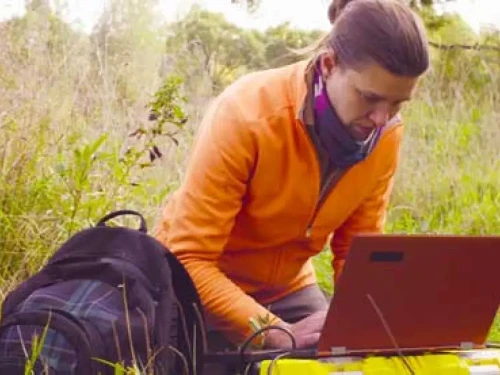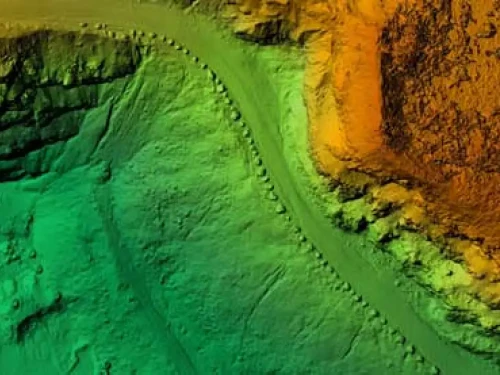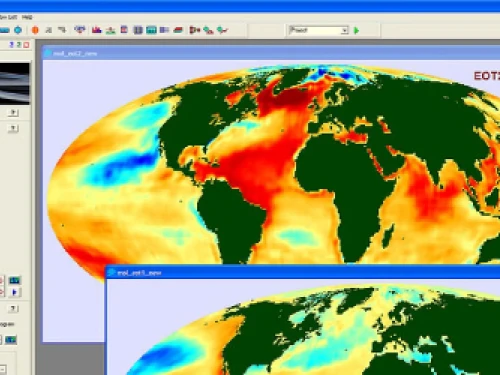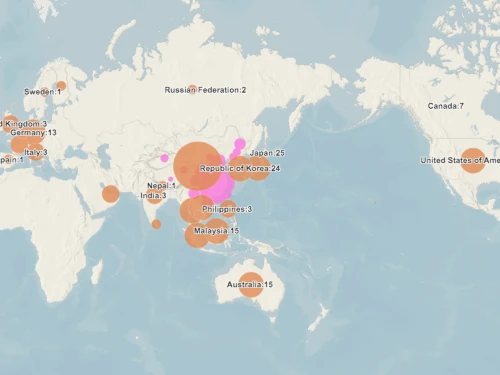Kent State Online Blog
Geographic Information Science
Explore the evolving world of Geographic Information Science (GISc) through Kent State’s blog posts. Topics cover the increasing demand for GIS professionals, the difference between GISc and GIS, and the wide-ranging applications of GISc in fields like urban planning, environmental management, and data storytelling. Learn about exciting career paths, industry developments, and Kent State faculty’s academic achievements in this rapidly growing field.
Related Blog Posts
Why an Online Master of Geographic Information Science Degree is the Gateway to a High-Demand Career
The need for geospatial professionals has skyrocketed in recent years, with industries like urban planning, public health, transportation, and environmental management relying heavily on Geographic Information Science (GISc). An online Master’s in Geographic Information Science from Kent State University offers the skills, flexibility, and credentials needed to enter or advance in this high-demand field. Here’s why this program is your gateway to a thriving geospatial career.
In today’s data-driven world, the ability to analyze and interpret spatial data has never been more critical. Geographic Information Science (GISc) addresses challenges ranging from urban planning and environmental sustainability to public health and disaster response. Pursuing a 100% online Master’s in Geographic Information Science at Kent State University equips students with in-demand skills to thrive in this dynamic field. Here’s a closer look at the top five skills you’ll gain from this program.
Geographic Information Science (GISc) professionals are at the forefront of solving real-world challenges through spatial data analysis. Whether mapping natural disasters, optimizing urban planning, or tracking global health trends, their work is dynamic, impactful, and deeply connected to improving lives. Kent State University’s 100% online Master of Geographic Information Science program prepares students for diverse and rewarding careers in this high-demand field.
Kent State University is proud to welcome Assistant Professor Patrick Bitterman, Ph.D., who joined us as a new tenure-track faculty member in the Department of Geography at Kent State University this semester! Bitterman comes to us from the School of Global Integrative Studies at the University of Nebraska-Lincoln, where he worked as an assistant professor of geography since 2019 and as a postdoctoral research associate at the University of Vermont (2017-2019).
Natural disasters like hurricanes, wildfires, and earthquakes can devastate communities, but Geographic Information Science (GISc) plays a critical role in preparing for, responding to, and recovering from these events. By leveraging spatial data and advanced technology, GIS professionals provide actionable insights that save lives, protect property, and guide recovery efforts.
In today’s digital age, Geographic Information Systems (GIS) have become an indispensable tool across various industries, from urban planning and homeland security to environmental management and beyond.
Author: Katherine Jurak, Kent State University
Careers in GIS are in demand more than ever. Equipped with data visualization and spatial analysis skills, GIS professionals qualify for occupations in countless fields.1
Even if you’re considering enrolling in a GIS program and pursuing a GIS master’s degree, you may not realize how prevalent Geographic Information Science (GISc) is in our world.
The American Geophysical Union (AGU) recently appointed Scott Sheridan, Ph.D., professor and chair of the Department of Geography and professor in the online Geographic Information Science (GISc) programs, to its inaugural cohort for the Leadership Academy and Network for Diversity and Inclusion in the Geosciences (AGU LANDInG). AGU LANDInG’s Academy is a 2-year commitment supporting its participating Fellows to move from people, culture, and belonging advocacy to DEI leadership through concrete efforts with a focus on evidence-based resources and practices.
Have you heard of the term “geographic information science (GISc)”?
He Yin, Ph.D., assistant professor in Kent State University’s Department of Geography in the College of Arts and Sciences, recently received NASA’s New (Early Career) Investigator Award in Earth Science. The award will provide funding for Yin’s research on the effects of the Syrian civil war on croplands throughout the eastern Mediterranean region.
Geographical information science (GISc) is a fascinating and diverse discipline, expanding rapidly into nearly every industry across the globe. Geospatial technologies support fields as widely varied as agriculture, climatology, disaster management, energy production, infrastructure, healthcare, law enforcement, logistics, marine sciences, national defense and real estate. If you’re detail-oriented and enjoy working with statistics, mathematics and powerful computer technologies, earning an online certificate in GISc will significantly boost your career opportunities as a GIS professional.
A recent scan of Geographic Information System (GIS) news stories highlights its critical role in conservation efforts, tropical cyclone risk assessment; citywide collaboration, planning and response; electrical utility infrastructure resilience and U.S. Department of Transportation planning and operation.1,2,3,4,5 These are just a few examples of the far-reaching influence GIS and Geographic Information Science (GISc), the science behind this technology, has in our lives. The global market for GIS was $8.1 billion in 2020 and has a projected growth of $14.5 billion by 2025.6 There’s no better time to get involved in this red-hot field by arming yourself with the education and credentials necessary to compete for the most lucrative, in-demand and rewarding jobs.
Acronyms can be confusing, especially when two abbreviations relate to the same field. An example is geographic information systems (GIS) and geographic information science (GISc). Although both acronyms are rooted in the science of geography, the roles of GIS and GISc differ.
A GISc program can help professionals advance their knowledge and prepare for work in fields such as anthropology, economics, geoscience, market research, political science, disaster relief, real estate, surveying or urban planning. GISc professionals can choose from a broad spectrum of careers in different sectors, from the government to cartographers or geoscientists.
A whole variety of career opportunities are available for professionals in the field of geographic information systems (GIS) and geographic information science (GISc). These fields are among the fastest-growing disciplines, requiring a broad spectrum of skills in environmental sciences, digital technologies and project management. There are exciting, high-paying GIS and GISc careers for every interest, whether you enjoy being outdoors and exploring natural environments, have a passion for sustainable urban development or prefer the challenge of operating high-tech digital tools in an office setting.
Geographic Information Science (GISc) is a field of study that covers a range of socio-political, geographical and informational disciplines. It involves the use of various technologies for recording and analyzing spatial and geographic data in a useful and easily-accessible manner. Using computer-based applications, GIS frameworks allow engineers and technicians to create interactive queries from collected data and produce visually compelling data maps.
The term “geographic information science” (GISc) might be unfamiliar or seem a little obscure, but it’s actually a rapidly growing profession with careers in high demand. The world is increasingly reliant on GISc graduates with skills in geographic information systems in a wide variety of industries. From software development and law enforcement to climate scientists and urban planners, GISc is an important field of study.

What is a Geographic Information Sciences Master’s Degree?
Even if you’re thinking about enrolling in a GIS program and pursuing a GIS master’s degree, you may not realize how prevalent Geographic Information Science (GIScience) is in our world. It is the science behind the devices that are woven into our daily lives. Geographical Information Systems (GIS) are everywhere, from the mapping applications on our phones to systems that monitor our health, manage communications networks, plan disaster response and study environmental sustainability.1
From global climate change to regional virus outbreaks, geographic information systems (GIS) are used to analyze and answer an entire spectrum of issues associated with geographic space. The researchers and analysts addressing these issues typically have academic degrees in Geographic Information Science (GISc), providing the scientific knowledge, skills and training in specialized computer-based GIS apps.1 Tech-based careers requiring degrees in GISc include a wide variety of fields such as national defense, meteorology, climatology, marine sciences, earth sciences, energy production, biotech, agriculture, healthcare, law enforcement, real estate, logistics, infrastructure and disaster risk management and relief.
You’re tech-savvy and fascinated by geography, but is there a career in that? Consider this, from the geographic information system company Esri:
Whether you thrive in the sunshine or the snow, near water or mountains, in big cities or under big sky, we have good news for you: there are geographic information science jobs all over the country.
Geography Professor Scott Sheridan has been named a recipient of the 2020 Outstanding Research and Scholarship Award (ORSA). Sponsored by the University Research Council and the Division of Research and Economic Development, this award honors Kent State’s exceptional researchers and scholars. Recipients are selected based on the quality of their research and scholarship, and its impact on society.
When you tune in to a local weather forecast or reach your destination with the help of a GPS device, you’re reaping the benefits of geographic information system (GIS) remote sensing technology. GIS was first applied in the 1960s to collect and analyze data regarding land usage. Today, there are a myriad of GIS applications ranging from urban planning to predicting the environmental effects of climate change. GIS technology continues to develop, creating an ever-increasing need for skilled professionals.1
If you’re researching either geographic information systems or geographic information science, it can sometimes be difficult to distinguish one from the other. Although geographic information science is often confused with geographic information systems, and the two terms are closely related, they are not perfectly interchangeable.1
If you’re researching either geographic information systems or geographic information science, it can sometimes be difficult to distinguish one from the other. Although geographic information science is often confused with geographic information systems, and the two terms are closely related, they are not perfectly interchangeable.1
Discover how mapping coronavirus transmission can prevent outbreaks in countries outside of mainland China.
Geographic information science (GISc) is a broadly applicable degree that can be used in many fields around the world, including healthcare, climatology, urban development, national parks and more.1 Working in GISc could take you to places as different as a laboratory or the deep wilderness. For example, you might use the skills you have learned to protect the environment, study volcanic activity in other areas of the world, or support the homeless population in your city.2 If you have an analytical mind and are good at visualizing information, you can use GISc technology to tell stories that help others and better understand and serve the world around you in countless different ways.
Geographical information systems (GIS) are the backbone for geographical science and all its related fields. Modern geography uses sophisticated, highly specialized technology to gather, analyze and report on data about positions on Earth’s surface.1





























